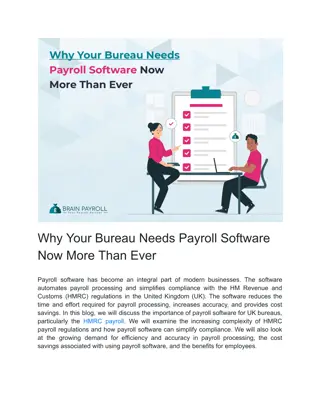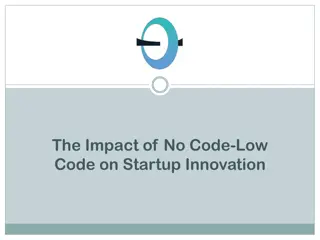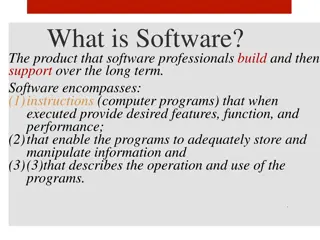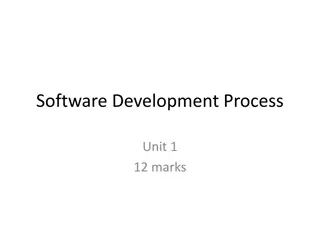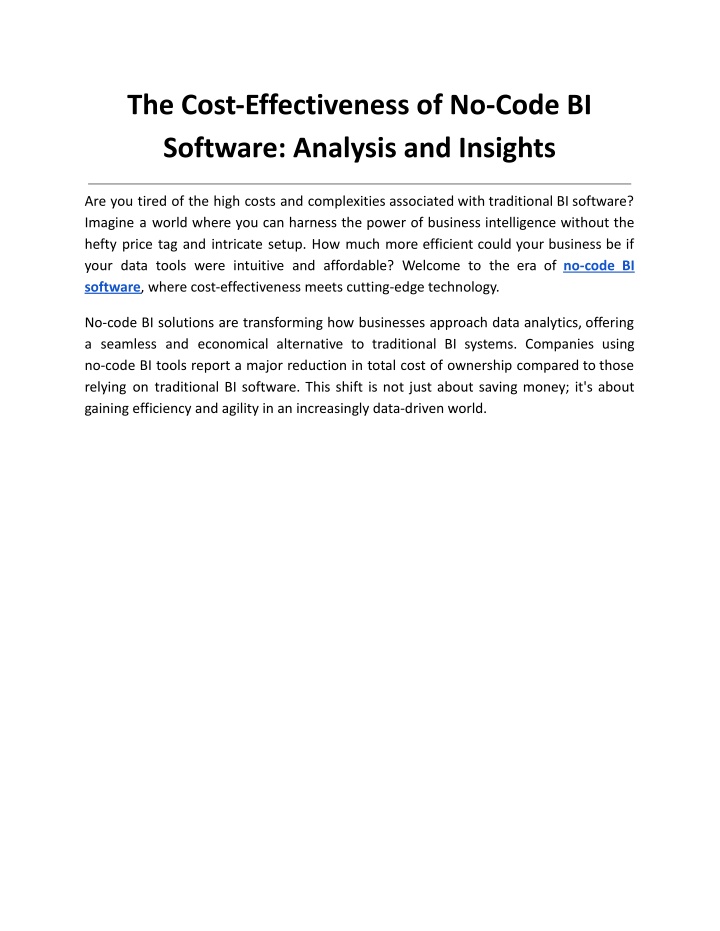
The Cost-Effectiveness of No-Code BI Software_ Analysis and Insights
Could switching to no-code BI software significantly cut your company's expenses and streamline your operations? This blog uncovers the economic and operational advantages of adopting no-code solutions for business intelligence, highlighting their po
Download Presentation

Please find below an Image/Link to download the presentation.
The content on the website is provided AS IS for your information and personal use only. It may not be sold, licensed, or shared on other websites without obtaining consent from the author. If you encounter any issues during the download, it is possible that the publisher has removed the file from their server.
You are allowed to download the files provided on this website for personal or commercial use, subject to the condition that they are used lawfully. All files are the property of their respective owners.
The content on the website is provided AS IS for your information and personal use only. It may not be sold, licensed, or shared on other websites without obtaining consent from the author.
E N D
Presentation Transcript
The Cost-Effectiveness of No-Code BI Software: Analysis and Insights Are you tired of the high costs and complexities associated with traditional BI software? Imagine a world where you can harness the power of business intelligence without the hefty price tag and intricate setup. How much more efficient could your business be if your data tools were intuitive and affordable? Welcome to the era of no-code BI software, where cost-effectiveness meets cutting-edge technology. No-code BI solutions are transforming how businesses approach data analytics, offering a seamless and economical alternative to traditional BI systems. Companies using no-code BI tools report a major reduction in total cost of ownership compared to those relying on traditional BI software. This shift is not just about saving money; it's about gaining efficiency and agility in an increasingly data-driven world.
Consider the case of Houwzer, a modern real estate agency in Philadelphia. They revolutionized their business model with technology and a salaried team of experts, saving home sellers an average of $11,000. However, they faced significant challenges in data organization and manual reporting. Greg Phillips, Houwzer's Chief Technology Officer, sought a solution to centralize their data and streamline reporting. His search led him to Grow's no-code BI software. Phillips found that Grow allowed him to consolidate various information sources, providing live updates and high visibility across the office. This transparency enabled their teams to track conversion rates from leads to closed deals in real-time, fostering a competitive and data-driven culture. "Implementing BI really isn t a question," Phillips said.
"You have to look at the data for your decisions because if you go with your opinions, your decisions could be way off-base." In this blog, we'll delve into the cost-effectiveness of no-code BI software, offering detailed analysis and insights to help you understand why this technology is the future of business intelligence. We'll compare the total cost of ownership (TCO) of traditional and no-code BI tools, highlight efficiency and productivity gains, and showcase real-world examples like Houwzer to illustrate the substantial benefits. Stay tuned to discover how No-code Business Intelligence solutions can transform your business operations, enhance decision-making speed, and ultimately save you money. Cost Components of Traditional BI Software Implementing traditional BI software often involves significant costs, impacting various aspects of a business's financial and operational landscape. Initial Setup Costs Software Purchase or Licensing Fees Acquiring traditional BI software typically requires a substantial initial investment. Businesses often need to purchase licenses for each user or pay for a perpetual license, which can be a considerable expense, especially for large organizations. This upfront cost can strain budgets, particularly for small to mid-sized enterprises. Hardware and Infrastructure Investments In most cases, solid hardware and infrastructure are required for traditional BI systems. Companies must invest in high-performance servers, data storage solutions, and networking equipment to support the software's demands. These infrastructure investments not only increase initial setup costs but also require ongoing maintenance and upgrades to keep up with technological advancements. Maintenance and Support Costs Ongoing IT Support and Maintenance Expenses
Maintaining a traditional BI system demands continuous IT support. Companies often need to hire or contract skilled IT professionals to manage the system, ensure its smooth operation, and troubleshoot any issues that arise. This ongoing support is a recurring cost that can accumulate over time, impacting the total cost of ownership. Costs of Software Updates and Upgrades BI software vendors regularly release updates and upgrades to improve functionality, security, and performance. While these updates are crucial, they come with additional costs. Businesses must allocate a budget for purchasing new versions, implementing updates, and training staff on new features. This cycle of updates can be both financially and operationally taxing. Training and Development Costs Training Staff to Use Complex BI Tools Traditional BI tools often have a steep learning curve, requiring extensive training for staff. Businesses must invest in comprehensive training programs to ensure employees can effectively use the software. This training is not only time-consuming but also adds to the overall cost, as it may involve hiring external trainers or dedicating internal resources to education. How Much Time and Money Go Into Making Tailored Solutions In order to make BI solutions fit the demands of individual businesses, customization is typically required. Developing these custom solutions requires significant time and resources. IT teams must work closely with business users to understand requirements, design custom reports, and integrate various data sources. This process can be lengthy and expensive, diverting resources from other critical projects. Cost Components of No-Code BI Software Adopting no-code BI software can provide significant cost savings and operational efficiencies for businesses. Here's a detailed analysis of the cost components associated with no-code BI software aimed at helping business users, data analysts, and BI professionals understand its financial and practical benefits. Lower Initial Investment
Subscription-Based Pricing Models No-code BI software often operates on a subscription-based pricing model, which offers several financial advantages. Instead of a large upfront payment, businesses can spread costs over time with manageable monthly or annual fees. This model not only reduces the initial financial burden but also allows for predictable budgeting and financial planning. Furthermore, subscription plans often include ongoing support and updates, providing continuous value without unexpected expenses. Minimal Hardware Requirements One of the standout features of no-code BI tools is their minimal hardware requirements. Unlike traditional BI systems that demand significant investments in servers and data storage, no-code BI solutions leverage cloud infrastructure. This approach eliminates the need for expensive on-premises hardware, reducing both initial setup costs and ongoing maintenance expenses. Businesses can deploy and scale their BI capabilities without investing in physical infrastructure, making it an attractive option for companies of all sizes. Reduced Maintenance Costs Cloud-Based Solutions with Automated Updates
No-code maintenance cost reductions. Cloud-based solutions come with automated updates, ensuring that the software is always up-to-date with the latest features and security patches. This automation eliminates the need for manual updates and the associated downtime, allowing businesses to focus on data analysis rather than IT maintenance. Additionally, cloud providers handle the underlying infrastructure, further reducing the need for dedicated IT support. BI software is predominantly cloud-based, which brings substantial Decreased Need for Dedicated IT Support With traditional BI systems, businesses often require a team of IT professionals to manage, troubleshoot, and support the infrastructure. No-code BI tools drastically reduce this need. Their user-friendly nature means that even non-technical staff can handle many tasks that previously required IT intervention. This reduction in IT dependency not only lowers costs but also speeds up the resolution of issues, improving overall productivity and efficiency. User Training and Adoption Intuitive User Interfaces Reducing Training Time A key advantage of no-code BI software is its intuitive user interface. Designed with the end-user in mind, these interfaces simplify the process of creating reports, visualizations, and dashboards. Employees can quickly learn to navigate and utilize the software without extensive training. This ease of use translates to reduced training costs and faster onboarding times, enabling teams to leverage BI capabilities almost immediately after implementation. Faster Adoption Rates Leading to Quicker ROI The simplicity and accessibility of no-code BI tools lead to higher and faster adoption rates across the organization. When employees can easily integrate BI tools into their daily workflows, the business can start reaping the benefits of data-driven decision-making sooner. This rapid adoption accelerates the return on investment (ROI), as the business can quickly capitalize on insights gained from data analysis. The quicker the adoption, the sooner the company can see improvements in efficiency, productivity, and profitability.
Comparative Analysis Total Cost of Ownership (TCO) When evaluating business intelligence solutions, understanding the Total Cost of Ownership (TCO) is crucial. There are typically hefty initial expenditures associated with traditional BI software, like as licensing fees, hardware investments, and maintenance costs over the long run. Conversely, subscription-based model, spreading costs over time and reducing initial financial burdens. no-code BI software operates on a Traditional BI Software: The TCO for traditional BI systems includes high initial licensing fees, substantial hardware purchases, and ongoing IT maintenance. Companies must also consider the costs of software updates, staff training, and custom solution development. These factors collectively contribute to a higher TCO over the software's lifespan. No-Code BI Software: The TCO for no-code BI tools is considerably lower. Subscription-based pricing models eliminate hefty upfront costs, and cloud-based infrastructure reduces the need for expensive hardware. Additionally, automated updates and reduced IT support requirements contribute to lower maintenance costs, making No-code Business Intelligence solutions more financially viable in the long term. Case Studies or Examples Illustrating Cost Savings 1. Small to Mid-Sized Business: A mid-sized retail company transitioned from a traditional BI system to a no-code BI solution. Initially, they spent $150,000 on licenses and hardware for their traditional BI setup. The yearly expenditures for support and maintenance reached $50,000, with an additional $20,000 going into training new employees. By switching to a no-code BI software with a $2,000 monthly subscription, the company reduced its TCO by over 50%, with additional savings from decreased IT support needs. 2. Large Enterprise: A large manufacturing firm faced escalating costs with its traditional BI system, including $500,000 in initial setup costs and $200,000 annually for maintenance and support. Transitioning to a no-code BI solution at $10,000 per month led to a substantial reduction in their TCO, saving the
company millions over a five-year period while also enhancing their data analysis capabilities. Efficiency and Productivity Gains Users can develop and manage dashboards, data visualizations, reports, and more with no-code BI software, which greatly improves workflow efficiency. The intuitive interfaces and drag-and-drop functionality allow users to quickly generate insights, reducing the dependency on IT departments and accelerating data-driven decision-making. Streamlined Reporting: No-code BI tools simplify the reporting process. Business users can easily pull data from various sources, customize reports, and share insights with stakeholders. This reduces the time spent on manual data handling and reporting, allowing teams to focus on analysis and strategy. Automation and Integration: Many no-code BI solutions offer automation features, such as scheduled reporting and real-time data updates. These capabilities ensure that decision-makers always have access to the latest information, enhancing responsiveness and agility in business operations. Impact on Business Operations and Decision-Making Speed The adoption of no-code BI tools has a profound impact on business operations and decision-making speed. By providing immediate access to data and enabling rapid analysis, these tools empower businesses to make informed decisions swiftly. Faster Decision-Making: With traditional BI systems, generating reports and insights often involves multiple steps and considerable time. No-code BI software eliminates these delays, allowing users to access and analyze data in real-time. This speed is crucial in dynamic business environments where timely decisions can provide a competitive edge. Operational Efficiency: By streamlining data workflows and reducing the burden on IT resources, no-code BI solutions enhance overall operational efficiency. Employees can allocate more time to strategic initiatives rather than getting bogged down by technical tasks, leading to improved productivity and business performance.
Conclusion The analysis of the cost-effectiveness of no-code BI software demonstrates its substantial advantages over traditional BI systems. With lower initial investments, reduced maintenance costs, and simplified user training, no-code BI solutions offer a financially and operationally attractive alternative. Businesses can achieve significant cost savings while enhancing their data analysis capabilities, leading to better decision-making and overall improved performance. Grow's no-code BI software exemplifies these benefits, providing a robust, cost-effective solution tailored to meet the dynamic needs of modern businesses. By adopting Grow s no-code BI tools, organizations can unlock the full potential of their data without the hefty price tag and complexities of traditional BI systems. Take the next step towards transforming your business intelligence strategy with Grow. Experience firsthand how our no-code BI solution can revolutionize your data operations. Sign up for a 14-day free demo today and discover the efficiency and cost savings Grow can bring to your organization. Curious about what others have to say? Check out "Grow Reviews Cost & Features GetApp" to see how Grow is helping businesses like yours achieve their BI goals. Don't miss out on the opportunity to elevate your data strategy with Grow s innovative no-code BI software. Original Source: https://bit.ly/3SwyaN4

